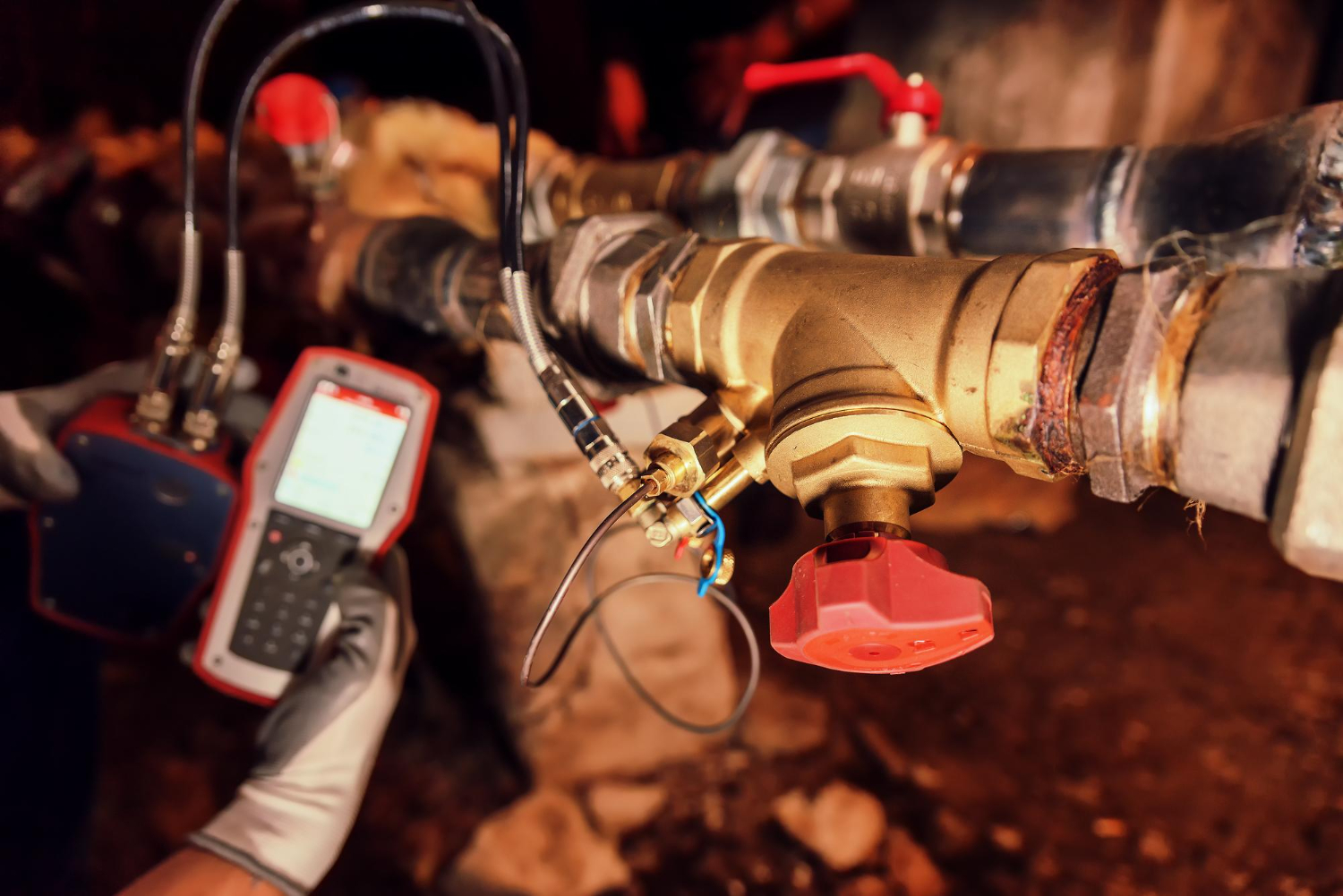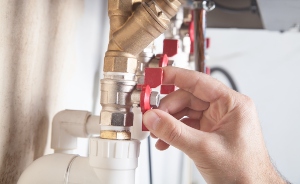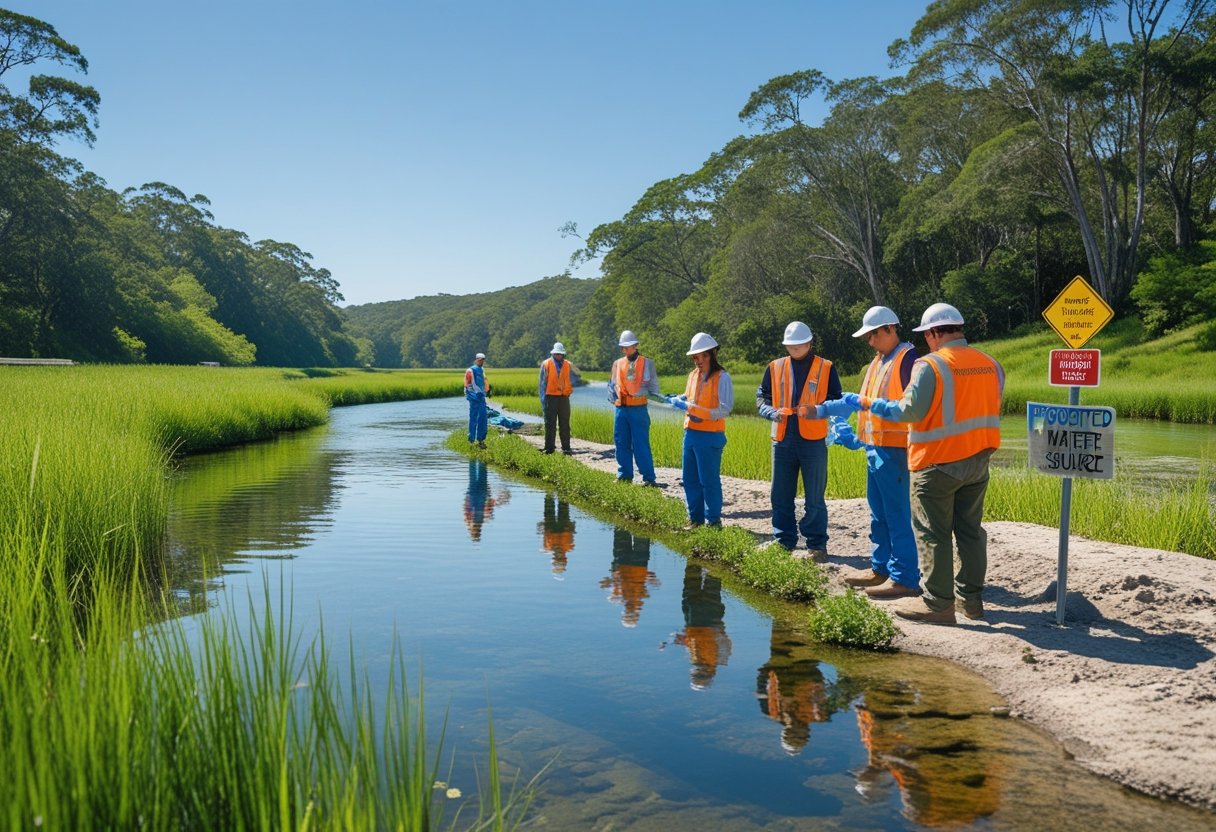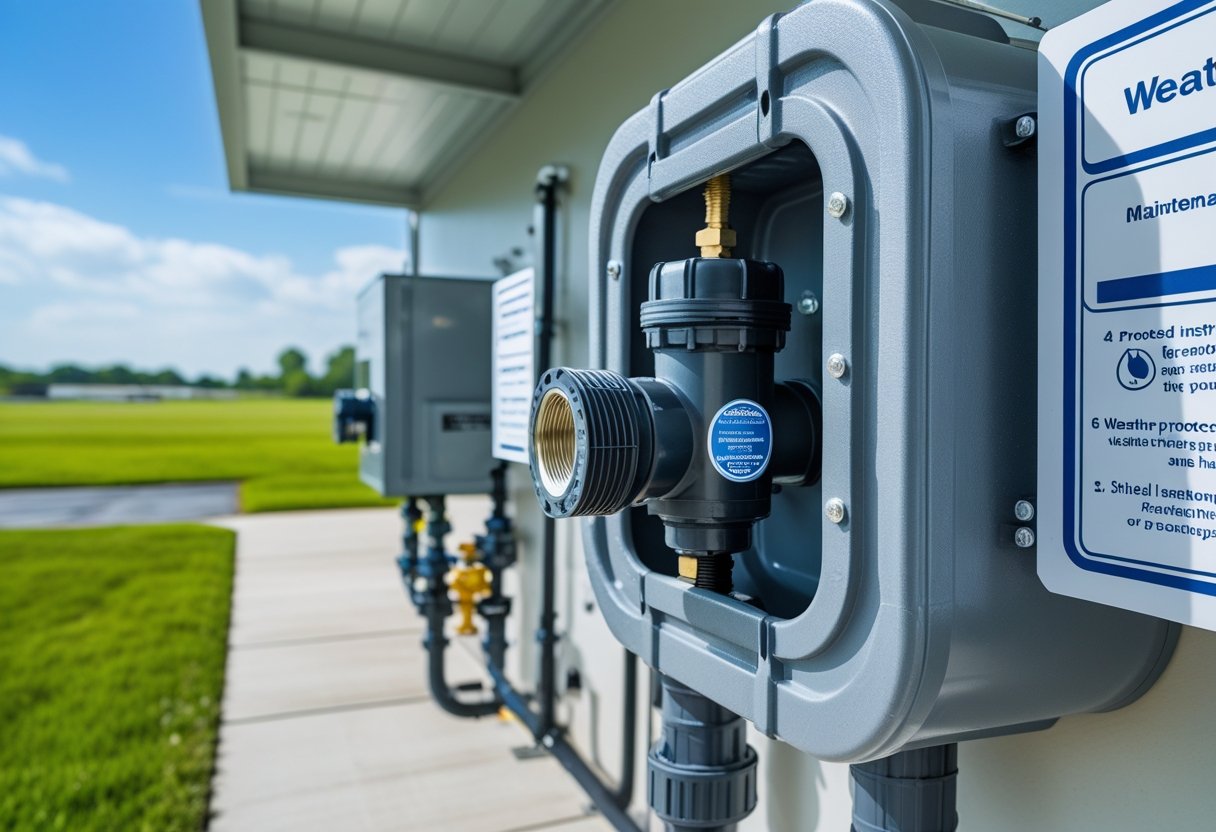Many homeowners receive notices from their city or water department about backflow testing and wonder what it means for them. Residential backflow testing is a procedure that uses special gauges to check if devices designed to prevent contaminated water from flowing back into the clean water supply are working properly.
These backflow prevention devices protect drinking water from contamination that could come from irrigation systems, pools, or other water sources connected to a home's plumbing. Without proper testing, these devices can fail due to wear or debris, putting the entire neighborhood's water supply at risk.
Most cities require annual backflow testing for homes with sprinkler systems, pools, or other cross-connections.
In this article, you’ll learn how residential backflow testing protects your home’s water supply and what it takes to stay compliant.
Let’s break down the key points you should consider.
- Understanding backflow and why testing matters
- What residential backflow testing includes
- Backflow testing cost and how often to schedule it
- DIY or pro testing: what's allowed and what isn't
- Choosing a provider that keeps you compliant without stress
Keep reading! Understanding the testing process, costs, and requirements helps homeowners stay compliant while protecting their water quality and avoiding potential fines.
Understanding backflow and why testing matters
Backflow preventers work as safety barriers in home plumbing systems, while certain areas like irrigation systems and boilers create the highest contamination risks. Most areas require annual testing by certified professionals to meet local water safety codes.
What a backflow preventer does to protect your home's water
A backflow preventer acts like a one-way valve in your plumbing system. It stops contaminated water from flowing backward into your clean water supply.
These devices work by creating a physical barrier between your home's water and potential contamination sources. When water pressure drops in the main supply line, the preventer automatically closes.
Two main types protect homes:
- Check valves - Simple devices that close when water tries to flow backward
- Reduced pressure zone devices - More complex systems with multiple valves and test ports
The device contains springs and seals that respond to pressure changes. When normal water flow occurs, these parts stay open to allow clean water through.
If pressure reverses, the internal parts quickly shut to block dirty water. This prevents chemicals, bacteria, or other harmful substances from entering your drinking water.
Most preventers also have test ports that allow technicians to check if the device works properly. Without regular testing, homeowners cannot know if their protection system actually functions when needed.
Where backflow risks hide at home: irrigation, boilers, and hose bibs
Irrigation systems create the biggest backflow risk in most homes. These systems mix water with fertilizers, pesticides, and soil bacteria that can seriously harm your health.
Underground sprinkler lines often have direct connections to your main water supply. If pressure drops while the system runs, contaminated water can flow back into your pipes.
Boiler systems pose another major threat. These units contain chemicals that prevent rust and scale buildup in the heating system.
Water heaters and radiant floor heating systems use similar chemicals. A pressure change can pull these substances into your drinking water.
Hose bibs seem harmless but cause many contamination problems. Garden hoses left in pools, fertilizer sprayers, or on dirty ground create direct paths for bacteria.
Pet washing stations and outdoor utility sinks also connect to these same water lines. The closer these connections are to your main water supply, the higher the contamination risk becomes.
Other common risk areas include:
- Swimming pool fill lines
- Fire sprinkler systems
- Industrial equipment connections
- Laboratory or workshop plumbing
Residential backflow requirements you should know before you book
Most local codes require annual testing of backflow preventers by certified professionals. These rules apply to homes with irrigation systems, pools, or other high-risk connections.
Testing requirements vary by location but typically include:
- Annual inspection and testing
- Written test reports filed with local water authority
- Immediate repairs if devices fail testing
- Certification of technician performing tests
Property owners usually receive notices from their water department about upcoming testing deadlines. Missing these deadlines can result in fines or water service interruption.
The testing process takes 30-60 minutes per device. Technicians use special gauges to measure pressure and check valve operation.
Common residential backflow requirements:
- Properties with irrigation systems must test annually
- New installations need initial testing before activation
- Failed devices must be repaired within 10 days
- Test reports must be submitted within 30 days
According to the U.S. Environmental Protection Agency, backflow prevention programs require that assemblies be tested, inspected, and maintained by certified technicians, with accurate record‑keeping of all inspections, test results, and repairs.
Some areas require testing only when water pressure changes occur in the neighborhood. Others mandate testing regardless of system usage or pressure conditions.
Homeowners should check with their local water authority for specific requirements in their area.
What residential backflow testing includes
Residential backflow testing follows a standard procedure using specialized gauges and test equipment. The process takes about 30 to 45 minutes and results in either a pass or fail certification that gets reported to local water authorities.
In many jurisdictions, including under WSSC Water rules, testable backflow preventers must undergo annual testing, and test results must be submitted to the water authority within 30 days; assemblies that fail must be cleaned, rebuilt, or replaced.
Step-by-step test procedure with gauges and shutoffs explained
The technician starts by shutting off the water supply downstream from the backflow device. They connect test gauges to specific test ports on the assembly.
Initial setup steps:
- Locate the backflow prevention assembly
- Turn off downstream shutoff valve
- Attach test gauge kit to test ports
- Record initial pressure readings
The tester checks each valve inside the device separately. They measure pressure drops across check valves and relief valves. The gauges show if water can flow backward through the system.
Key measurements include:
- Check valve #1: Must hold back at least 1 PSI of pressure
- Check valve #2: Must also hold back at least 1 PSI
- Relief valve: Must open within 2 PSI of check valve pressure
The technician operates shutoff valves in specific sequences. They watch gauge readings to see if each part works correctly. Any valve that fails to hold proper pressure means the device fails the test.
How long the visit takes and what to do before the tech arrives
Most residential backflow tests take 30 to 45 minutes to complete. Simple assemblies may finish in 20 minutes. More complex systems can take up to an hour.
Before the technician arrives:
- Clear access to the backflow device
- Remove any plants or debris around the area
- Make sure the device location is accessible
- Have previous test reports ready if available
The device is usually located near the water meter or where the main line enters the property. Some homes have the assembly in a basement or utility room.
Homeowners should plan for a brief water shutoff during testing. The technician will restore water service immediately after completing the test. Most people can continue normal activities during the visit.
Pass or fail, certification, and the paperwork your city expects
The backflow device either passes or fails the test. There are no partial passes or conditional approvals.
Passing requirements:
- All check valves hold proper pressure
- Relief valve opens at correct pressure
- No internal leakage detected
- All shutoff valves operate smoothly
Failed devices must be repaired or replaced before retesting. The technician will explain which parts need attention and provide repair recommendations.
Required documentation includes:
- Official test report with gauge readings
- Technician's certification number
- Device serial number and manufacturer
- Test date and next due date
The testing company typically submits reports directly to the city or water department. Homeowners receive a copy for their records. Cities use this paperwork to track compliance and maintain water system safety records.
Backflow testing cost and how often to schedule it
Most homeowners pay between $50 and $150 for annual backflow testing, though prices can range from $30 to $300 depending on location and system complexity. Testing must happen yearly in most areas to meet local water safety rules.
Typical backflow testing cost and what changes the price
Backflow testing costs vary based on several key factors. Most residential properties pay $50 to $150 per device for annual testing.
Location plays a big role in pricing. Urban areas often charge more than rural locations due to higher business costs and stricter regulations.
The type of backflow preventer affects the price too. Simple residential devices cost less to test than complex commercial systems.
Factors that increase testing costs:
- Multiple devices on the property
- Hard-to-reach or underground devices
- Failed tests that need repairs
- High-demand areas with fewer certified testers
Most homes have just one backflow preventer. Commercial properties often have 2 to 3 devices, which increases the total cost.
Some areas with strict water safety rules charge premium prices. The availability of certified testers in your area also affects pricing.
How often a backflow needs to be tested to stay compliant
Most local water authorities require annual backflow testing for residential properties. This yearly schedule helps ensure water safety and prevents contamination.
Testing frequency depends on local regulations rather than property owner preference. Some areas may require testing every six months for high-risk properties.
Common testing schedules:
- Residential properties: Once per year
- Commercial properties: Once per year
- High-risk facilities: Every 6 months
- New installations: Within 30 days
Property owners are responsible for scheduling and paying for these tests. Missing the annual deadline can result in water service disconnection in many areas.
Water utilities often send reminder notices before testing deadlines. Some areas allow a grace period, but most enforce strict compliance dates.
Easy ways to bundle testing with annual service and save a trip
Many plumbing companies offer service packages that combine backflow testing with other annual maintenance tasks. This approach saves time and often reduces overall costs.
Common bundling options include combining testing with water heater maintenance, pipe inspections, or seasonal plumbing checkups.
Popular service bundles:
- Backflow testing + water heater flush
- Testing + annual plumbing inspection
- Testing + irrigation system winterization
- Testing + sump pump maintenance
Some companies offer multi-year contracts with small discounts for loyal customers. These agreements lock in current pricing and guarantee annual service dates.
Scheduling testing with routine maintenance means fewer service calls and less disruption to daily routines. Many homeowners find this approach more convenient than separate appointments.
DIY or pro testing: what's allowed and what isn't
Most states require certified professionals to perform official backflow tests, but homeowners can do basic checks between annual inspections. The key difference lies between informal monitoring and legally required testing with calibrated equipment.
Can you do your own backflow test? Rules most homeowners miss
Homeowners cannot perform official backflow tests in most jurisdictions. States require licensed professionals to conduct annual testing because these tests must meet specific legal standards.
What homeowners can do:
- Visual inspections for leaks or damage
- Check for proper valve positioning
- Monitor water pressure changes
- Look for signs of backflow events
What requires a professional:
- Official annual testing with calibrated gauges
- Pressure differential measurements
- Relief valve testing
- Documentation for water utility compliance
The confusion often comes from the difference between monitoring and testing. Homeowners can monitor their backflow devices between professional inspections. This helps catch problems early but doesn't replace required testing.
Some homeowners try to use basic pressure gauges from hardware stores. These tools cannot provide the accuracy needed for official testing. Professional test kits cost thousands of dollars and need annual calibration.
Water utilities only accept test results from certified testers. Attempting to submit DIY test results will be rejected and may result in compliance violations.
Why many areas require certified testers and calibrated equipment
Backflow testing protects public water systems from contamination. Cities and counties mandate professional testing because the stakes are too high for amateur attempts.
Certification requirements typically include:
- Completing state-approved training programs
- Passing written and practical exams
- Maintaining continuing education credits
- Using properly calibrated equipment
Test equipment must receive annual calibration from approved laboratories. This ensures readings are accurate within required tolerances. Professional test kits measure pressure differentials to 0.1 PSI accuracy.
Certified testers understand how to interpret results correctly. They know when devices need repair versus replacement. They also complete proper documentation that satisfies regulatory requirements.
Insurance and liability issues also drive these requirements. Professional testers carry insurance coverage for testing errors. Homeowners who attempt their own testing assume full liability for any contamination events.
Water utilities face regulatory oversight from state agencies. They must demonstrate that all backflow devices receive proper testing. Accepting DIY results would violate these regulations.
Common mistakes that lead to retests, fines, or water shutoffs
The biggest mistake homeowners make is skipping annual testing altogether. Water utilities will shut off service for non-compliance after sending multiple notices.
Documentation errors include:
- Missing test dates or signatures
- Incomplete device information
- Incorrect test procedures
- Using uncalibrated equipment
Many homeowners hire unlicensed testers to save money. Water utilities reject these results and treat them as no test at all. This leads to compliance violations and potential service shutoffs.
Some property owners delay repairs when devices fail testing. Most jurisdictions give 30 days to fix problems. Failing to repair devices within this timeframe triggers additional penalties.
Fines vary by location but typically range from $100 to $500 per violation. Repeat offenders face higher penalties and more frequent inspections.
Another common error is testing the wrong device type. Some backflow preventers are non-testable and require replacement instead of testing. Homeowners waste time and money trying to test these devices.
Water service reconnection after shutoff requires additional fees. These costs often exceed what homeowners would have paid for proper testing in the first place.
Choosing a provider that keeps you compliant without stress
Finding the right backflow testing company means looking for proper credentials, fast reporting, and reliable service. The best providers handle paperwork directly with your water authority and offer quick turnaround times.
Questions to ask about credentials, reporting, and reminders
Licensed technicians are required for valid backflow testing. Property owners should verify that the testing company holds current certifications from their state or local authority.
Key credentials to verify:
- State plumbing or backflow testing license
- Certification from American Society of Sanitary Engineering (ASSE)
- Insurance coverage for liability protection
Reporting systems matter for compliance. Companies should provide detailed test reports that meet local water authority requirements. These reports document valve performance and any repairs needed.
Smart providers offer reminder services. They track when annual tests are due and contact customers ahead of deadlines. This prevents last-minute scrambling and potential fines.
Ask about their equipment calibration schedule. Test gauges must be calibrated regularly to ensure accurate readings that water authorities will accept.
Same-day certificates and direct filing with your water authority
Speed matters when deadlines approach. Professional testing companies often provide same-day certificates after completing successful tests.
Direct filing saves property owners time and stress. Many companies submit test results directly to local water authorities electronically. This eliminates the risk of lost paperwork or missed filing deadlines.
Benefits of direct filing services:
- No paperwork for property owners to handle
- Faster processing by water authorities
- Reduced chance of compliance issues
- Electronic tracking of submission status
Some companies also handle failed test notifications. If a backflow device fails testing, they coordinate repairs and retesting without requiring multiple service calls from the property owner.
Need a certified test and report this week? Pacific Backflow can test, certify, and file for you
Pacific Backflow offers expedited testing services for urgent compliance needs. Their licensed technicians can schedule tests within days of contact.
The company handles the complete process from testing to filing. After completing tests, they provide official certificates and submit results directly to local water authorities.
Their service covers residential properties with flexible scheduling options. Evening and weekend appointments help accommodate homeowner schedules without disrupting work hours.
Pacific Backflow maintains proper equipment calibration and carries full licensing for residential backflow testing. Property owners receive documentation needed for compliance records.
Conclusion
Backflow testing protects families from contaminated water entering their home's drinking supply. This simple process helps prevent serious health risks and keeps water systems working properly.
Regular testing is required by law in most areas. Property owners who skip testing may face fines up to $2,000 or water service disconnection.
The testing process should be done by certified professionals who understand backflow prevention devices. These experts can test, repair, and replace equipment when needed.
Testing typically happens once per year. Some areas may require testing more often depending on local rules and the type of backflow device installed.
Property owners should schedule testing before their deadline each year. Many professionals offer reminder services to help customers stay on track with their requirements.
The investment in testing is small compared to the protection it provides. Clean water systems depend on working backflow prevention devices that get checked regularly.
Homeowners who prioritize this testing show they care about their family's health and safety. They also avoid the stress of dealing with water service problems or contamination issues later.
Schedule your residential backflow test with a certified technician today to stay compliant and protect your home’s drinking water.











